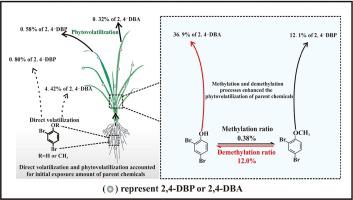Environment International ( IF 10.3 ) Pub Date : 2020-06-25 , DOI: 10.1016/j.envint.2020.105888 Qing Zhang 1 , Wenqian Kong 2 , Linfeng Wei 2 , Yingjun Wang 2 , Yadan Luo 2 , Pu Wang 1 , Jiyan Liu 2 , Jerald L Schnoor 3 , Guibin Jiang 2

|
The structural analogs, 2,4-dibromophenol (2,4-DBP) and 2,4-dibromoanisole (2,4-DBA), have both natural and artificial sources and are frequently detected in environmental matrices. Their environmental fates, especially volatilization, including both direct volatilization from cultivation solution and phytovolatilization through rice plants were evaluated using hydroponic exposure experiments. Results showed that 2,4-DBA displayed stronger volatilization tendency and more bioaccumulation in aboveground rice tissues. Total volatilized 2,4-DBA accounted for 4.74% of its initial mass and was 3.43 times greater than 2,4-DBP. Phytovolatilization of 2,4-DBA and 2,4-DBP contributed to 6.78% and 41.7% of their total volatilization, enhancing the emission of these two contaminants from hydroponic solution into atmosphere. In this study, the interconversion processes between 2,4-DBP and 2,4-DBA were first characterized in rice plants. The demethylation ratio of 2,4-DBA was 12.0%, 32.0 times higher than methylation of 2,4-DBP. Formation of corresponding metabolites through methylation and demethylation processes also contributed to the volatilization of 2,4-DBP and 2,4-DBA from hydroponic solution into the air phase. Methylation and demethylation processes increased phytovolatilization by 12.1% and 36.9% for 2,4-DBP and 2,4-DBA. Results indicate that phytovolatilization and interconversion processes in rice plants serve as important pathways for the global cycles of bromophenols and bromoanisoles.
中文翻译:

水稻植物中 2,4-二溴苯酚和 2,4-二溴茴香醚的吸收、植物挥发和相互转化。
结构类似物 2,4-二溴苯酚 (2,4-DBP) 和 2,4-二溴茴香醚 (2,4-DBA) 既有天然来源,也有人工来源,经常在环境基质中检测到。使用水培暴露实验评估了它们的环境命运,特别是挥发,包括从栽培溶液中直接挥发和通过水稻植物挥发。结果表明,2,4-DBA在水稻地上组织中表现出更强的挥发趋势和更多的生物积累。总挥发的 2,4-DBA 占其初始质量的 4.74%,是 2,4-DBP 的 3.43 倍。2,4-DBA 和 2,4-DBP 的植物挥发占其总挥发量的 6.78% 和 41.7%,增加了这两种污染物从水培溶液向大气的排放。在这项研究中,2,4-DBP 和 2,4-DBA 之间的相互转化过程首先在水稻中得到表征。2,4-DBA的去甲基化率为12.0%,是2,4-DBP甲基化的32.0倍。通过甲基化和去甲基化过程形成相应的代谢物也有助于 2,4-DBP 和 2,4-DBA 从水培溶液挥发到空气相中。甲基化和去甲基化过程使 2,4-DBP 和 2,4-DBA 的植物挥发增加了 12.1% 和 36.9%。结果表明,水稻植物中的植物挥发和相互转化过程是溴酚和溴苯甲醚全球循环的重要途径。通过甲基化和去甲基化过程形成相应的代谢物也有助于 2,4-DBP 和 2,4-DBA 从水培溶液挥发到空气相中。甲基化和去甲基化过程使 2,4-DBP 和 2,4-DBA 的植物挥发增加了 12.1% 和 36.9%。结果表明,水稻植物中的植物挥发和相互转化过程是溴酚和溴苯甲醚全球循环的重要途径。通过甲基化和去甲基化过程形成相应的代谢物也有助于 2,4-DBP 和 2,4-DBA 从水培溶液挥发到空气相中。甲基化和去甲基化过程使 2,4-DBP 和 2,4-DBA 的植物挥发增加了 12.1% 和 36.9%。结果表明,水稻植物中的植物挥发和相互转化过程是溴酚和溴苯甲醚全球循环的重要途径。

































 京公网安备 11010802027423号
京公网安备 11010802027423号